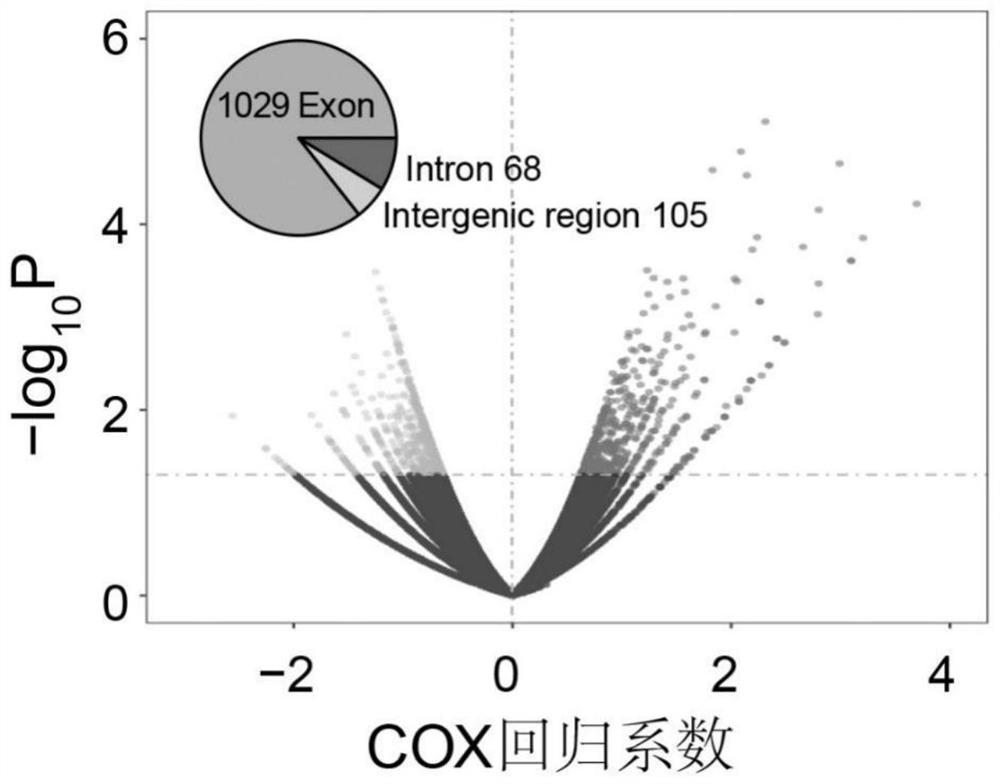Human esophageal squamous cell carcinoma circular RNA marker and application thereof
A technology for squamous cell carcinoma of the esophagus, applied in the field of biomedicine, can solve difficult problems and achieve the effects of improving clinical prognosis, not easy to degrade, and improving accuracy
- Summary
- Abstract
- Description
- Claims
- Application Information
AI Technical Summary
Problems solved by technology
Method used
Image
Examples
Embodiment 1
[0041] Example 1: Determining the expression characteristics of circular RNAs associated with the prognosis of ESCC patients.
[0042]Based on 73 pairs of ESCC patient RNA-seq (ribosome sequencing) data circular RNA expression profiles and clinical follow-up data, we screened out 1202 prognostic-related circular RNAs, of which 1029 circular RNAs were derived from exons (exon ), 105 circular RNAs were derived from intergenic regions, and 68 circular RNAs were derived from introns (Intron) (see figure 1 ).
[0043] In order to obtain the combination with the best prognostic ability, the applicant conducted a random survival forest variable analysis (RSFVH analysis) for the top 300 and 200 highly expressed circular RNAs among the 1202 prognostic-related circular RNAs, and screened out 17 For prognostic-related circular RNAs, the 17 circular RNAs were verified in ESCC tissues and cell lines by designing primers, and only 9 circular RNAs were found to be expressed, and the other 8...
Embodiment 2
[0047] Example 2: Expression of 4 circular RNA markers in 8 randomly selected ESCC patient cancer tissues and cell lines.
[0048] It was found that 4 circular RNAs (hsa_circ_0000005, hsa_circ_0007541, hsa_circ_0008199 and hsa_circ_0077536) were genuinely present (expressed) in ESCC patients and cell lines (see image 3 ). in image 3 A is the sequencing data of 4-circular RNA markers (hsa_circ_0000005, hsa_circ_0007541, hsa_circ_0008199, hsa_circ_0077536) in ESCC patient cancer tissue; image 3 B is the expression of 4-circular RNA markers (hsa_circ_0000005, hsa_circ_0007541, hsa_circ_0008199, hsa_circ_0077536) in cancer tissues and cell lines KYSE140, KYSE150, KYSE180, KYSE270 and KYSE410 of 8 randomly selected ESCC patients Cancer8-Cancer15. This provides a theoretical and experimental basis for the four circular RNAs as prognostic indicators for ESCC patients.
Embodiment 3
[0049] Example 3: Determination of the ability of 4-circular RNA markers to predict the prognosis of ESCC patients
[0050] In the sequencing data set, according to the expression levels of the four circular RNAs in ESCC patient cancer tissues, the risk score of ESCC patients was calculated, and ESCC patients were divided into high-risk group and low-risk group according to the median risk score, Kaplan-Meier Analysis of survival curve results showed that the overall survival of ESCC patients in the high-risk group was significantly lower than that in the low-risk group (1.91 years vs. 3.72 years, p Figure 4 A).
[0051] In the PCR verification data set, according to the expression levels of the four circular RNAs in ESCC patient cancer tissues, the risk score of ESCC patients was calculated, and ESCC patients were divided into high-risk resistance and low-risk resistance according to the median risk score, Kaplan- The results of Meier survival curve analysis also indicated th...
PUM
 Login to View More
Login to View More Abstract
Description
Claims
Application Information
 Login to View More
Login to View More - Generate Ideas
- Intellectual Property
- Life Sciences
- Materials
- Tech Scout
- Unparalleled Data Quality
- Higher Quality Content
- 60% Fewer Hallucinations
Browse by: Latest US Patents, China's latest patents, Technical Efficacy Thesaurus, Application Domain, Technology Topic, Popular Technical Reports.
© 2025 PatSnap. All rights reserved.Legal|Privacy policy|Modern Slavery Act Transparency Statement|Sitemap|About US| Contact US: help@patsnap.com



